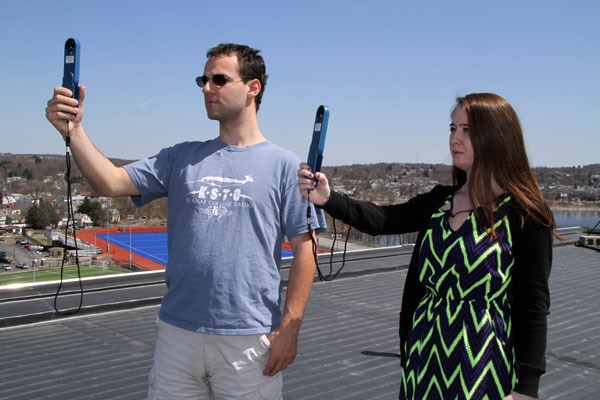Data Will Shed Light on Runners’ Performance

04/17/2015
By Edwin L. Aguirre
For the fourth year in a row, a team of 16 atmospheric science students will be closely monitoring the weather during this year’s Boston Marathon, providing live weather reports along the route of the 26.2-mile race.
The Boston Athletic Association (BAA), which organizes the event, has asked the university to keep tabs on the weather on behalf of the club. The students will be positioned at five locations — at the starting line in Hopkinton, the 10K (6.21-mile) mark in Framingham, the halfway (13.04-mile) mark in Wellesley, the 30K (18.64-mile) mark near “Heartbreak Hill” in Newton and the finish line in Boston.
The students will measure temperature, relative humidity, wind speed and direction as well as local sky and road conditions in real time and relay them by phone or text message to their fellow team members at the BAA media center at Boston’s Fairmont Copley Plaza.
“The members will then record the readings and make them available immediately to the press,” says Prof. Frank Colby of the Environmental, Earth and Atmospheric Sciences (EEAS) Department, who is heading the team. “The BAA will also share the data through social media in real time.”
Begun in 1897, the Boston Marathon is the world’s most prestigious and oldest annual race, attracting nearly 30,000 amateur and professional runners from around the world each year. It is viewed by up to half a million spectators annually, making it the most widely watched sporting event in New England. The telecast airs in more than 100 countries.
The Boston Marathon has had its share of wide-ranging New England weather throughout its history, from torrential rains in 2007 to exceptional heat in 2004 and 2012, plus snow, sleet and even snow squalls in earlier decades. So it’s important to keep a constant, vigilant eye on the sky.
“The data will help organizers characterize the climatology for each race,” explains Colby. “It will also help them understand how local weather affects the runners’ performance.”
He adds: “Our students will be able to gain an appreciation for the art and science of taking good observations. Participating in this activity is a way for them to support a high-profile event in our own region, and is an opportunity for all of us to demonstrate the quality of UMass Lowell and its students.”
A Learning Experience beyond the Classroom
“I love it. It’s awesome!” says senior Corinne Clifford of Haverhill, who is participating for the third time. “The event combines my two passions — running and the weather. I was a runner in high school and I had been going to Boston every year to watch the marathon. But actually taking part in the event is definitely special.”
Clifford plans to be a middle-school or high-school science teacher in her hometown after she graduates in May.
“I’m excited to see the mass of humanity at the starting line,” says junior Henry Goodwin of Nashua, N.H., who will be stationed in Hopkinton. “This is my first Boston Marathon.”
Goodwin hopes to become a researcher and eventually a teacher in the future. “I like to do science. I would like to use radar technology to help solve some of the mysteries of tornadoes, thunderstorms and other severe weather. I like learning about our home planet,” he says.
For David Coe of Leominster, this is going to be his fourth year participating in the marathon.
“It’s a fantastic experience. It gives us a chance to apply what we’ve learned in the classroom to the field,” says Coe, who plans to pursue a master’s degree in atmospheric science at UMass Lowell after graduation. “I’m very much interested in atmospheric modeling and climate change.”
A Great Springboard
Established in 1967 by Prof. Robert Curtis as the Department of Meteorology at the then Lowell Technological Institute, the EEAS Department has proven to be a great springboard for launching careers as researchers and TV weather forecasters.
Many of the big-city TV stations across the country have UMass Lowell graduates on their weather teams. They include Danielle Niles ’06 and Barry Burbank ’72 of Boston’s WBZ-TV News and Sarah Wroblewski ’05 and Shiri Spear ’07 of Fox 25 News.
